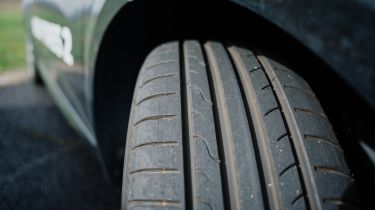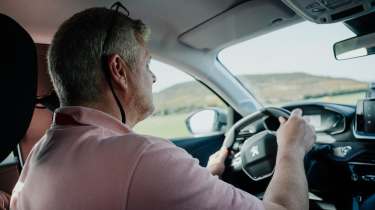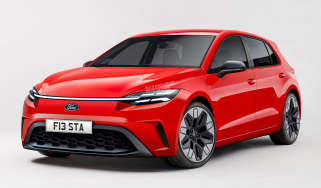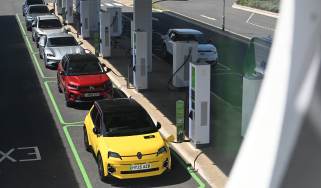Drivers changing car tyres too early are wasting their money and hurting the planet
Why running tyres all the way to the 1.6mm legal limit makes sense for safety and the environment
Drivers worried about approaching the 1.6mm legal limit for tyre tread depth and thinking about getting new rubber for their car early should think again. That’s the advice from the experts at Michelin tyres, but it comes with an important caveat. Not all tyres are created equal.
New EU legislation requires all new car tyres to deliver a high level of performance all the way down to 1.6mm of tread remaining. Letting your tyres wear down close to, but not beyond, 1.6mm will save you cash, reduce pollution and actually improve your car’s efficiency but beware. The difference in performance between the best and worst tyres on the market as their tread depth decreases can be significant. We got the full lowdown from Michelin’s experts and put their advice to the test…
Change your car tyres close to the legal limit
Michelin’s core message is that we shouldn’t be focused on tread depths when considering tyre wear, as long as we’re above the legal limit of 1.6mm - that’s the baseline number it considers to be essential to shift 1mm of surface water from a rain soaked road and the legal minimum tread depth in the UK. Instead, we should be focusing on tyre performance at lower tread depths below 3mm, because a decent tyre should look after you all the way down to that legal limit.
Indeed, that’s the reasoning behind the EU’s introduction of new regulations for wet braking performance of worn tyres at 1.6mm, which must now achieve minimum standards formerly only required of a new tyre. Worn tyres must achieve 88 per cent of the wet braking performance of the industry standard ASTM reference tyre, while the standard for new tyre wet braking is 110 per cent of the ASTM reference tyre’s performance.
However Cyrille Roget, Michelin’s communications director for science and innovation, tells us the French company isn’t satisfied with the current level of regulation and wants worn tyre wet braking tests to mirror those when new. “The test is set at a level that we judge is not strong enough to eliminate the worst performing tyres from the market,” Cyrille tells us. “We hope there will soon be a new evolution of the regulation that is more demanding.”
While consumers may reasonably think new tyre tread depths provide optimum grip, the standard 8mm of new tread is itself a trade-off. “A tyre is always a balance between how much longevity you want, and how much rolling resistance you need for the planet, fuel economy and performance,” says Cyrille. “At 12mm a tyre will have much better longevity, but in rolling resistance, it'll be terrible.”
“So you start with a tire at eight mm, should you remove it at seven, six or five? You don't know because there could be a tyre that at five mm is worse than a tyre at 1.6 mm. And that’s exactly what we showed, our tyres, worn, are better than some competitor tyres when new”.
It’s a convincing argument, but what’s behind this new focus on minimum performance standards instead of tread depth? Predictably, it’s all about the environment.
According to Michelin’s global vice president of brands, Gary Guthrie, around half the tyres fitted to the cars on the road today will be removed and discarded with more than 3mm of tread left. That equates to 25 per cent of their potential useful life, and is a horrendous statistic when looked at from an environmental perspective.
“One of the fundamental environmental qualities of any product is to deliver high performance for the longest possible usage time. That's the anti-obsolescence argument, and we agree with it,” he tells us.“400 million tyres are scrapped prematurely every year, and if you think about what 400 million tyres looks like in terms of landfill, or in terms of tyres being burned in cement kilns, it’s an incredible waste of resources, and of waste to deal with.”
According to Guthrie, there’s a range of reasons why car tyres are swapped prematurely, including sales pressure from the garage and tyre trade. However, Michelin is also concerned that customers lack the confidence to continue using tyres until the end of their life, simply because they’re not certain they’ll be safe. According to Guthrie, all Michelin tyres (aside from a few niche products like off-road tyres) perform when worn all the way down to the legal limit. That gives the consumer confidence to continue using their tyres right down to 1.6mm, saving precious resources, he suggests.
Changing tyres and the impact on the environment
There are other environmental challenges facing the tyre industry too. In particular, tyres are recognised as the biggest source of microplastic particulates in Europe. Michelin claims to be leading the game there too, with Guthrie pointing to tests performed by the German Automobile Club - ADAC.
“The way to do this is quite simple. You put four tyres on a car, you drive it a certain distance, you take them off again, you weigh them and see how much rubber they've lost,” he says. “if you put four tyres on a car and you drive 20,000 kilometres, with Michelin Cross Climates you lose about a kilo and a half of rubber.”
That may sound a lot, but according to Michelin the average for tyres sold in the European market is three and a half kilos of rubber, while the worst offenders can dump up to 8 kilos into the environment. “It’s colossal,” admits Guthrie, saying Michelin is in favour of the EU implementing a legal threshold, which would outlaw those tyres which abrade too rapidly.
It’s an issue coming more into focus in the EV transition, he suggests, as tyre and road wear particulates are the only significant emission from electric cars, while Michelin’s own data suggests an electric car will typically wear its tyres 20 per cent faster than an internal combustion equivalent. “That’s because it's a bit heavier, because it has more torque, and because with regenerative braking there’s always drive in one direction or the other in the tyres,” says Guthrie.
Good tyres can boost efficiency by 7 per cent
Sticking with the environmental issues, energy production plays a key role in the impact of tyres - but according to Michelin it’s the usage phase, and not production or scrapping which has the biggest environmental impact. Rolling resistance is the key metric here, which is measured in kilos per ton. “Go back to the early 1990s,” says Guthrie, “the average tyre had rolling resistance of around 12 kilos per ton. That was when we introduced the first Michelin energy tyre, which started the process of dramatically reducing that figure. Today, our best tyres operate at about 5 kilos per ton. So over the last 30 years, we have divided by more than a factor of two - if you think about the tyres using around 20 per cent of an EV’s energy consumption today, it’s gone down from twice that.”
According to the company’s figures, there’s a broad spread of performance available in the market, with the difference between “good tyres and bad tyres” being “about 7 per cent”. Guthrie says that difference is about 40 kilometres in the Tesla Model Y that he drives. “Not insignificant when you think how much it would cost in terms of increasing the size of the battery, um, to add another 40 kilometres to the range.”
Notwithstanding the challenges posed by EVs, Michelin has not opted to develop tyre technology that’s bespoke for them.
“If electric vehicles need tyres which ensure long-lasting safety, which are energy efficient and which are resistant abrasion, those are exactly the same performances that we need if we're going to reduce the environmental impact of the 90 to 98% of the car park, which are still running with the internal combustion engine vehicles in 2030,” says Guthrie. “We think it'd be a terrible mistake to restrict our best technologies to tyres for, for EVs, and that also has the useful side of benefit of simplifying the choice for consumers. We want to make our technologies available to the entire car parc, because that’s what’s necessary to reduce the environmental impact of our tyres, which are significant.”
We put low tread depth tyres to the test
Michelin unleashed us on the test tracks of its impressive facility in Ladoux, France, in a relatively humdrum Peugeot e208. The purpose: to demonstrate the capabilities of its Primacy 4 summer tyre while shaved to 2mm tread depth.
The track was sprayed to maintain a water depth of 1mm on the tarmac, simulating heavy rainfall, and a couple of laps were enough to confirm the reassuring levels of grip provided at both ends of the car; driving in such challenging conditions, on what are effectively almost ‘worn out’ Michelins, the Peugeot feels stable and predictable at all times.
Taking on the course in a second e208 fitted with a nameless competitor brand, also shaved to 2mm (Michelin stated the rival product was chosen at random, and we can’t identify it as the sidewall branding was erased), is certainly a more heart-in-mouth experience; not only is there much less grip at both ends when driving into, and through corners, but the transition from gripping to skidding feels more edgy and less predictable. An altogether less confidence inspiring experience as a result, with the comparative lack of stability and lower grip levels potentially more dangerous on the road in wet conditions.
Need new rubber for the colder months? These are the best winter tyres...
Find a car with the experts








